Embrace (the)
change.
Actor portrayal
Vagifem® contains estradiol (an estrogen hormone) in a vaginal insert and is used after menopause to treat moderate to severe menopausal changes in and around the vagina.
Actor portrayal
Embrace (the) change.
Actor portrayal
Menopause can mark a big shift in a woman’s life. Sometimes it causes bothersome vaginal changes. The good news is that Vagifem® 10 mcg estradiol vaginal inserts can treat some of these changes.

What is Vagifem®?
Vagifem® contains estradiol (an estrogen hormone) in a vaginal insert and is used after menopause to treat moderate to severe menopausal changes in and around the vagina. Vagifem® is placed directly into the vagina, right where you’re experiencing changes, to help replenish estrogen lost due to menopause.
The Vagifem® track record
Vagifem® has been FDA-approved since 1999, and women have been treated with it since that time. Multiple studies have been conducted regarding its safety and effectiveness.
Who should not take Vagifem®?
Do not start using Vagifem® if you:
- have unusual vaginal bleeding
- have been diagnosed with a bleeding disorder
- currently have or have had certain cancers
- had a stroke or heart attack
- currently have or have had blood clots
- currently have or have had liver problems
- are allergic to Vagifem® or any of the ingredients in it

What about side effects?
Common side effects of Vagifem® include headache, breast pain, irregular vaginal bleeding or spotting, stomach or abdominal cramps, bloating, nausea and vomiting, hair loss, fluid retention, and vaginal yeast infection. Serious but less common side effects have been reported; read about other possible side effects in the Prescribing Information and the Important Safety Information below. For more information, ask your healthcare provider or pharmacist. Tell your healthcare provider if you have any side effects that bother you or do not go away.
How Vagifem® works in your body
Not all estrogens are the same. The estrogen used in Vagifem® is called estradiol, which is the same estrogen your body makes. Vagifem® treats changes in and around the vagina that occur after menopause. Symptoms can include vaginal dryness, irritation, itching, and soreness; painful urination; and pain and bleeding during sex.
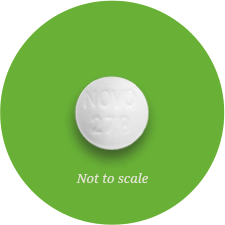
Get started
Whether you’re new to Vagifem® or resuming treatment after a break, you can get started here.
How to take it
Vagifem® is inserted into the vagina using a preloaded, single-use applicator. The following isn’t the complete set of instructions for use—please be sure to read all of the information in the Instructions for Use before you start.
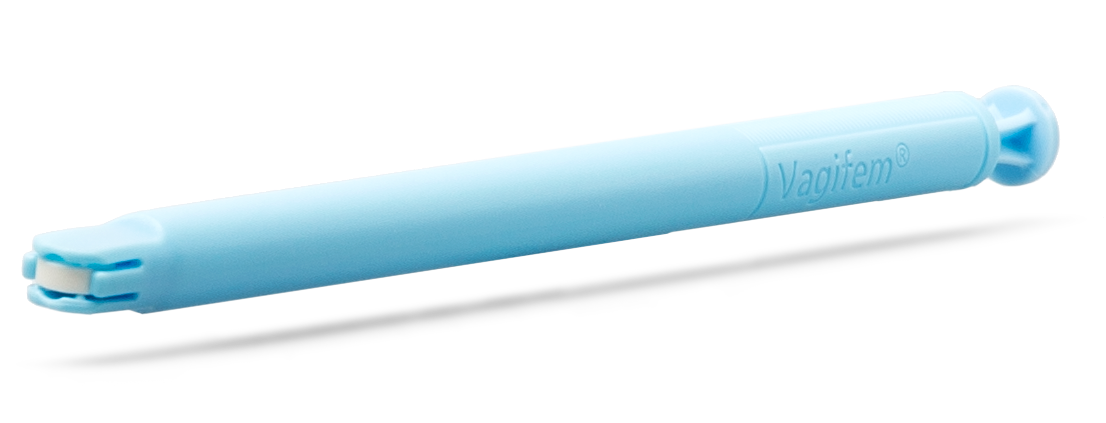
Step 1.
Tear off a single applicator.
Step 2.
Separate the plastic wrap and remove the applicator from the plastic wrap as shown in Figure A. If after opening the package you see that the insert has come out of the applicator but has not fallen out of the package, carefully put it back into the applicator for insertion. Please keep your hands clean and dry while handling the insert.
Step 3.
Hold the applicator so that the finger of one hand can press the applicator plunger as shown in Figure B.
Step 4.
Next, select the best position for vaginal insertion of Vagifem® that is most comfortable for you. See suggested reclining Figure C or standing Figure D position.
Step 5.
Using the other hand, guide the applicator gently and comfortably through the vaginal opening (see Figures C and D). If prior to insertion the insert falls out of the applicator, throw the insert and applicator away and use a new insert-filled applicator.
Step 6.
The applicator should be inserted (without forcing) as far as comfortably possible, or until half of the applicator is inside your vagina, whichever is less.
Step 7.
Once the insert-filled applicator has been inserted, gently press the plunger until the plunger is fully depressed. This will eject the insert inside your vagina, where it will dissolve slowly over several hours.
Step 8.
After depressing the plunger, gently remove the applicator and dispose of it the same way you would a plastic tampon applicator. The applicator is of no further use and should be discarded properly. Insertion may be done at any time of the day. It is advisable to use the same time daily for all applications of Vagifem®. If you have any questions, please consult your health care provider or pharmacist.
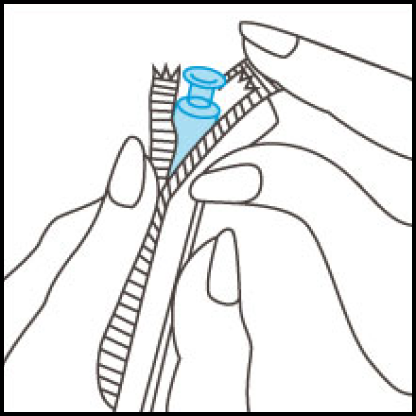
Figure A
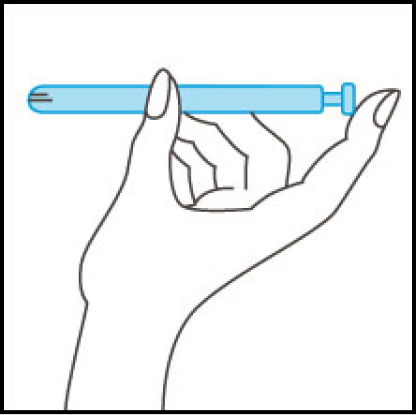
Figure B
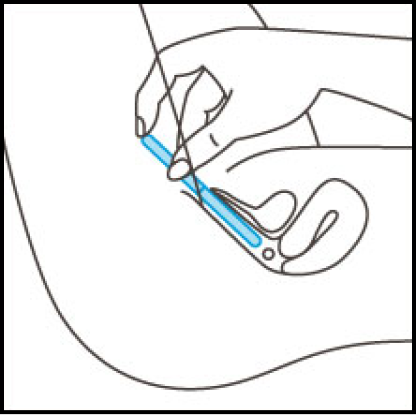
Figure C
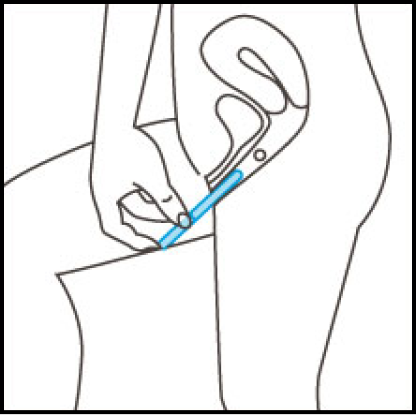
Figure D
When to take it
For the first 2 weeks, you’ll use Vagifem® once daily. After that, you’ll reduce to twice a week, as directed by your health care provider.
You choose the days you take Vagifem®. For example, you could take it every Tuesday and Friday, as shown in the dosing schedule below. You can use Vagifem® at any time of the day that you choose, but it should be done at the same time on each dosing day.
Store Vagifem® at room temperature: 68-77ºF (20-25ºC). Do not refrigerate.
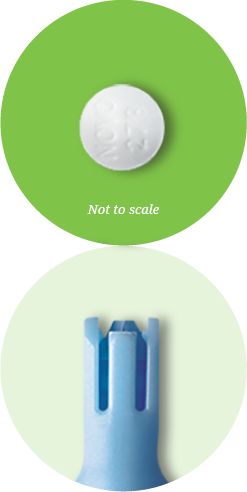
Vagifem® dosing schedule
Starting out
S
M
T
W
T
F
S
week 1:
1 Vagifem® 10 mcg insert every day







week 2:
1 Vagifem® 10 mcg insert every day







Going forward
S
M
T
W
T
F
S
week 3 and beyond:
1 Vagifem® 10 mcg insert twice a week; for example, Tuesday and Friday







What to expect going forward

When to look for results
Since Vagifem® works to address the underlying cause of your menopausal vaginal symptoms, you won’t experience results immediately. But that doesn’t mean it’s not working. One study showed that Vagifem® reduced a combined score of the most bothersome vaginal symptoms at 12 weeks. You may want to talk with your partner about what to expect, too.
How long you might stay on treatment
Once you have met your treatment goals, your health care provider may tell you to stop taking Vagifem®. You and your health care provider should talk regularly—for example, every 3 to 6 months—about whether you still need treatment with Vagifem® or, if you’ve been off treatment, whether it’s appropriate to resume. Estrogens should be used at the lowest dose possible for your treatment and only as long as you need to use this medicine.


Actor portrayal
Returning to treatment?
The menopausal condition that causes uncomfortable vaginal symptoms is called vaginal atrophy. It’s a chronic condition, meaning it’s ongoing; it can be treated, but not cured. That’s why it’s important to know your body, talk regularly with your health care provider, and continue paying attention to your symptoms.
Important Safety Information
What is the most important information I should know about Vagifem® (an estrogen hormone)?
- Using estrogen-alone may increase your chance of getting cancer of the uterus (womb).
- Report any unusual vaginal bleeding right away while you are using Vagifem®. Vaginal bleeding after menopause may be a warning sign of cancer of the uterus (womb). Your healthcare provider should check any unusual vaginal bleeding to find the cause.
- Do not use estrogen-alone to prevent heart disease, heart attacks, strokes, or dementia (decline of brain function).
- Using estrogen-alone may increase your chances of getting strokes or blood clots.
- Using estrogen-alone may increase your chance of getting dementia, based on a study of women age 65 years and older.
- Do not use estrogens with progestogens to prevent heart disease, heart attack, strokes, or dementia.
- Using estrogens with progestogens may increase your chances of getting blood clots, strokes, heart attacks, or breast cancer.
- Using estrogens with progestogens may increase your chance of getting dementia, based on a study of women 65 years of age and older
- Only one estrogen-alone product and dose have been shown to increase your chances of getting strokes, blood clots, and dementia. Only one estrogen with progestogen product and dose have been shown to increase your chances of getting heart attacks, strokes, breast cancer, blood clots, and dementia.
- Because other products and doses have not been studied in the same way, it is not known how the use of Vagifem® will affect your chances of these conditions. You and your healthcare provider should talk regularly about whether you still need treatment with Vagifem®.
What is Vagifem®?
Vagifem® (estradiol vaginal inserts) is a prescription medicine that contains estradiol (an estrogen hormone) in a vaginal insert. Vagifem® is used after menopause to treat moderate to severe menopausal changes in and around the vagina.
Important Safety Information
Who should not use Vagifem®?
Do not start using Vagifem® if you:
- have unusual bleeding
- have been diagnosed with a bleeding disorder
- currently have or have had certain cancers
- had a stroke or heart attack
- currently have or have had blood clots
- currently have or have had liver problems
- are allergic to Vagifem® or any of the ingredients in it
Before you use Vagifem®, tell your healthcare provider about all of your medical conditions, including if you:
- have any unusual vaginal bleeding
- have any other medical conditions that may become worse while you are using Vagifem®
- are going to have surgery or will be on bed rest
- are pregnant or think you may be pregnant
- are breastfeeding
Tell your healthcare provider about all of the medicines you take, including prescription and over-the-counter medicines, vitamins, and herbal supplements.
What are the possible side effects of Vagifem®?
Serious but less common side effects include: heart attack, stroke, blood clots, breast cancer, cancer of the lining of the uterus (womb), cancer of the ovary, dementia, high and low blood calcium, gallbladder disease, visual abnormalities, high blood pressure, high levels of fat (triglyceride) in your blood, liver problems, changes in your thyroid hormone levels, fluid retention, cancer changes of endometriosis, enlargement of benign tumors of the uterus (fibroids), worsening of swelling of face and tongue (angioedema) in women with a history of angioedema
Call your healthcare provider right away if you get any of the following warning signs or any other unusual symptoms that concern you:
- new breast lumps
- unusual vaginal bleeding
- changes in vision or speech
- sudden new severe headaches
- severe pains in your chest or legs with or without shortness of breath, weakness, and fatigue
Common side effects of Vagifem® include headache, breast pain, irregular vaginal bleeding or spotting, stomach or abdominal cramps, bloating, nausea and vomiting, hair loss, fluid retention, and vaginal yeast infection.
Please click here for Vagifem® Prescribing Information.
Vagifem® is a prescription medication.
You are encouraged to report negative side effects of prescription drugs to the FDA. Visit www.fda.gov/medwatch, or call 1-800-FDA-1088.
Novo Nordisk provides patient assistance for those who qualify. Please call 1-866-310-7549 to learn more about Novo Nordisk assistance programs.
Important Safety Information
What is the most important information I should know about Vagifem® (an estrogen hormone)?
- Using estrogen-alone may increase your chance of getting cancer of the uterus (womb).
- Report any unusual vaginal bleeding right away while you are using Vagifem®. Vaginal bleeding after menopause may be a warning sign of cancer of the uterus (womb). Your healthcare provider should check any unusual vaginal bleeding to find the cause.
- Do not use estrogen-alone to prevent heart disease, heart attacks, strokes, or dementia (decline of brain function).
- Using estrogen-alone may increase your chances of getting strokes or blood clots.
- Using estrogen-alone may increase your chance of getting dementia, based on a study of women age 65 years and older.
- Do not use estrogens with progestogens to prevent heart disease, heart attack, strokes, or dementia.
- Using estrogens with progestogens may increase your chances of getting blood clots, strokes, heart attacks, or breast cancer.
- Using estrogens with progestogens may increase your chance of getting dementia, based on a study of women 65 years of age and older
- Only one estrogen-alone product and dose have been shown to increase your chances of getting strokes, blood clots, and dementia. Only one estrogen with progestogen product and dose have been shown to increase your chances of getting heart attacks, strokes, breast cancer, blood clots, and dementia.
- Because other products and doses have not been studied in the same way, it is not known how the use of Vagifem® will affect your chances of these conditions. You and your healthcare provider should talk regularly about whether you still need treatment with Vagifem®.
What is Vagifem®?
Vagifem® (estradiol vaginal inserts) is a prescription medicine that contains estradiol (an estrogen hormone) in a vaginal insert. Vagifem® is used after menopause to treat moderate to severe menopausal changes in and around the vagina.
Important Safety Information
Who should not use Vagifem®?
Do not start using Vagifem® if you:
- have unusual bleeding
- have been diagnosed with a bleeding disorder
- currently have or have had certain cancers
- had a stroke or heart attack
- currently have or have had blood clots
- currently have or have had liver problems
- are allergic to Vagifem® or any of the ingredients in it
Before you use Vagifem®, tell your healthcare provider about all of your medical conditions, including if you:
- have any unusual vaginal bleeding
- have any other medical conditions that may become worse while you are using Vagifem®
- are going to have surgery or will be on bed rest
- are pregnant or think you may be pregnant
- are breastfeeding
Tell your healthcare provider about all of the medicines you take, including prescription and over-the-counter medicines, vitamins, and herbal supplements.
What are the possible side effects of Vagifem®?
Serious but less common side effects include: heart attack, stroke, blood clots, breast cancer, cancer of the lining of the uterus (womb), cancer of the ovary, dementia, high and low blood calcium, gallbladder disease, visual abnormalities, high blood pressure, high levels of fat (triglyceride) in your blood, liver problems, changes in your thyroid hormone levels, fluid retention, cancer changes of endometriosis, enlargement of benign tumors of the uterus (fibroids), worsening of swelling of face and tongue (angioedema) in women with a history of angioedema
Call your healthcare provider right away if you get any of the following warning signs or any other unusual symptoms that concern you:
- new breast lumps
- unusual vaginal bleeding
- changes in vision or speech
- sudden new severe headaches
- severe pains in your chest or legs with or without shortness of breath, weakness, and fatigue
Common side effects of Vagifem® include headache, breast pain, irregular vaginal bleeding or spotting, stomach or abdominal cramps, bloating, nausea and vomiting, hair loss, fluid retention, and vaginal yeast infection.
Please click here for Vagifem® Prescribing Information.
Vagifem® is a prescription medication.
You are encouraged to report negative side effects of prescription drugs to the FDA. Visit www.fda.gov/medwatch, or call 1-800-FDA-1088.
Novo Nordisk provides patient assistance for those who qualify. Please call 1-866-310-7549 to learn more about Novo Nordisk assistance programs.
